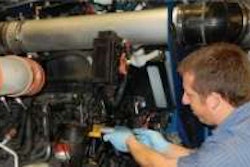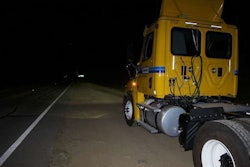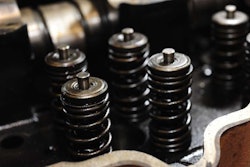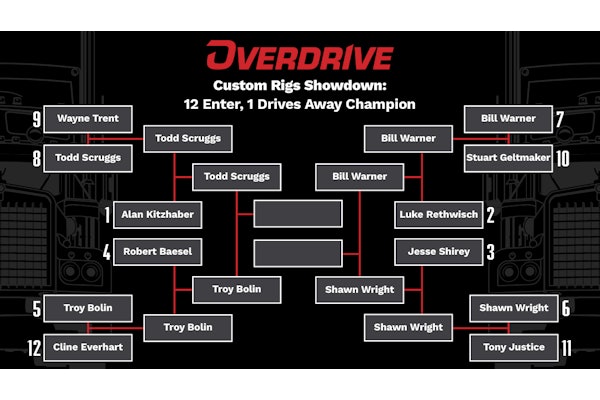 Antifreeze/coolant not only provides freezing protection, but it also inhibits corrosion for all cooling system metals through a wide range of temperatures.
Antifreeze/coolant not only provides freezing protection, but it also inhibits corrosion for all cooling system metals through a wide range of temperatures.Nothing tests a truck’s readiness for climate change like a hard, frigid blast of arctic air. That’s why winter preparation is an annual event for owner-operators, whether based in Minot, N.D., or Shreveport, La. Basic preparation can pay big dividends by avoiding unnecessary downtime.
Coolants
Whether you use conventional or extended-drain coolant, your coolant system should get the lion’s share of attention as sub-freezing temperatures approach. Here are tips to ensure your system is ready to endure the winter.
- At any preventive maintenance, check the system, especially clamps and hoses, for leaks. Make sure the coolant level is at the “full” mark. If not, pressurize the system to find leaks.
- Always use a high-quality coolant and additives from reputable suppliers. Do not rely on questionable marketing claims and unknown sources of engine coolant, which can provide marginal protection or create problems with new heavy-duty vehicles.
- Pull a sample of coolant and check the solution to see if the freeze point is appropriate. A 50-50 solution should protect your engine down to -34 degrees F. This can be measured by a handheld refractometer (the most accurate), test strip or hydrometer. This measurement tells you only if the concentration of glycol and water is correct and if the freeze point protection is adequate.
- Use the test strips designed to test the key inhibitor levels for the coolant you are using to ensure they are preventing aeration, corrosion and cavitation. If in doubt, send a sample to a lab.
- Eyeball the solution sample in a see-through container. It should be clear with bright tint and free of any debris.
Batteries
Cold temperatures cause a battery to resist charge, often leaving it at a lower state of charge. This can increase the battery’s sulfation level and tax the battery’s cycle life, reducing overall life.
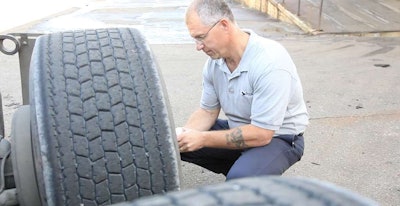 Always use a properly calibrated gauge when checking tire pressure.
Always use a properly calibrated gauge when checking tire pressure.Here are tips from Gale Kimbrough of Interstate Batteries, Maria Orlando-Krick of EnerSys and Brad Bisaillon of Trojan Battery.
- AGM (absorbed glass mat) batteries – just like flooded-cell types – come in starting, dual-purpose and deep-cycle options, so choose the correct battery for your needs.
- During PM intervals, routinely check the electrical system, clean the batteries and test and charge them.
- If batteries are 3 years old and winter is coming, consider early replacement.
- Checking a battery’s state of charge (SOC) is the best way to determine remaining useful life. A handheld battery and electrical system tester will allow you to diagnose bad batteries rapidly and precisely in a discharged state.
- An alternate method to check SOC is a digital voltmeter to measure open circuit voltage (OCV). Do not measure the OCV until at least six to eight hours after the battery has been charged to ensure the battery has reach a state of equilibrium. The manufacturer’s specifications will indicate what OCV corresponds to 100 percent SOC.
- Spec batteries with adequate discharge capacity. If the vehicle’s use demands discharge at a consistent 20 to 30 percent, spec batteries that can offer hundreds of medium-duty cycles to ensure consistent performance.
- Remember that APU-tethered batteries often are discharged to a lower SOC than starting batteries, which can allow them to be susceptible to damage from freezing or not get fully charged. A HVAC system producing heat to keep a cab warm requires additional power in watts, so batteries in trucks with APUs typically will encounter reduced service life due to additional discharge demand.
- Trucks with APUs increase the amount of parasitic loads on batteries, which can reduce their cold weather life. Parasitic loads are small currents that the battery has to deliver continuously. Since parasitic loads can be applied on a long-term basis, the cumulative amp-hours (Ah) extracted from the battery can be significant.
- Lead-acid batteries perform best at 70 to 80 degrees F. When temperatures drop, increased hotel loads in the cab place more demand on the batteries.
- A battery’s recharge efficiency is reduced when cold, which strains the battery even more during the winter. You may be attempting to warm a cab with a battery that is not fully charged, leading to starting issues in the morning.
Tires
Tires do not demand a lot of extra attention in cold weather, but there are some important things to consider. Here are tips from Guy Walenga, director of commercial products and technology for Bridgestone Americas, and Paul Crehan, director of product marketing for Michelin Truck Tires.
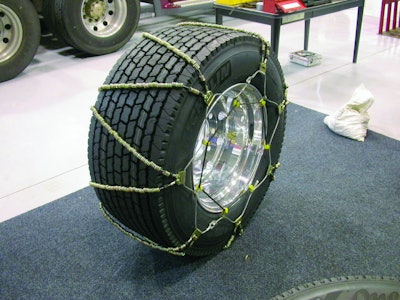 Use only good quality tire chains that fit properly. Put the chains on the tire, drive for about a mile, then check and retighten the chains to ensure a good fit.
Use only good quality tire chains that fit properly. Put the chains on the tire, drive for about a mile, then check and retighten the chains to ensure a good fit.• Maintain proper tire pressure. Since tire pressure drops in cold weather, set the pressure prior to driving when the tires are at ambient temperature. The ideal time to check pressure is during the pre-trip inspection.
- If the tire is 20 percent below the recommended pressure, it must be considered flat and removed and inspected for damage. Failure to do so easily could lead to unwanted downtime.
- If you’re checking air pressure in below-freezing temperatures, it’s possible that moisture in a tire, combined with rushing air, could cause ice to form quickly in a valve core and cause a slow pressure leak. Valve caps help combat this problem.

• If you routinely drive in areas with severe winter weather, consider tires with a specific tread pattern suited to those conditions. When tire inspections during winter show circumferential cutting, chunking, spin damage or tearing, it could point to weather-related low-traction conditions.
• Use tire chains where needed, especially when required by local law. Follow instructions from chain manufacturers and tire makers for proper mounting.
- Remove chains as soon as they no longer are needed. Chains left on for extended periods will chip, pit and chunk tires, as well as cause road damage.
Other systems
- Air dryers should be changed out prior to winter to ensure that ice does not cripple the vehicle’s air supply system.
- Have the correct oil viscosity for the climate. Check with engine makers or your oil supplier for cold-weather recommendations.
- When determining cold-weather viscosity, note that cold-weather oil performance is predicated on ambient air temperatures. Engines are not affected by wind chill values.
- In extreme climates, consider lower-viscosity 5W/40 oil that flows better in extreme cold temperatures – an important consideration if the truck sits up all night without idling.
- Do not waste money on cold-weather oil additives. Oil manufacturers blend engine oils for cold-weather performance.
- Check your washer fluid and make sure you have enough deicer/solvent solution to help defrost your windshield and keep the washer fluid jug from bursting due to freezing.
